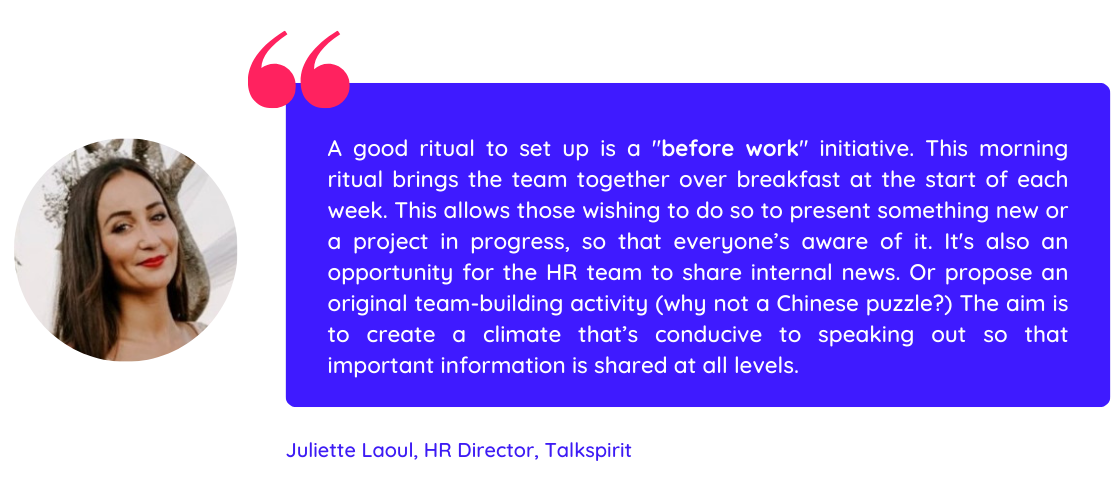Do your employees seem to avoid taking initiative? Promoting psychological safety at work can unleash their potential! This term is used to describe an environment where employees are not afraid to speak up : something that 89% of all American employees consider essential. And with good reason, as creating a “healthy” work environment is what enables employees to gain confidence and freely express their ideas. This, in turn, boosts your company’s innovation potential.
How does psychological safety play out in our professional environment? What are the possible levers for promoting it within each team? And how can we encourage the right to make mistakes? Here’s everything you need to know about psychological safety at work!
What is psychological safety?
Before promoting psychological safety at work, it’s important to understand what it is and what it means for your company. Here, then, is a definition to clarify these elements.
Coined in 1999, the term psychological safety refers to an employee’s ability to take risks, share ideas, and challenge the status quo without fear of negative consequences. Creating a psychologically safe environment therefore implies creating an organizational culture that destigmatizes failure—and in contrast—grants the right to make mistakes.
Once liberated with this newfound psychological security, employees are no longer afraid of being judged, ridiculed, or reprimanded for what they may have said or done. They know they can make mistakes along the way, and so feel freer to take initiative and propose innovative ideas.
Why invest in psychological safety?
For companies and employees alike, investing in psychological safety offers many advantages. For employers, it can help to develop employee engagement, improve talent retention, boost team performance, and encourage greater innovation. On the employee side, it’s a good way of improving workplace wellbeing and mental health, as well as boosting confidence and autonomy at work.
At a time when 44% of employees are experiencing stress at work, promoting psychological safety in the workplace is a win-win investment!
The more you develop psychological safety, the more this creates a positive loop for the company as a whole, says Gartner. Conversely, a work environment that is not psychologically safe will instead increase the fear of failure, encouraging the tendency to criticize and blame others. Employees then feel less inclined to take initiative and share opinions.

How can we promote psychological safety at work?
To promote psychological safety at work, companies can implement several best practices:
- Create a positive and caring work environment
- Keep the communication lines open in all directions
- Promote diversity, equity, and inclusion
- Demonstrate transparency
- Set clear objectives
- Encourage continuous improvement
- Create connections among employees
- Develop your leadership’s skills
Whether you’re an HR manager, internal communications manager, team manager, or even a CEO, we strongly encourage you to apply these best practices! And of course, we still have more to share below. 😉
1. Create a positive and caring work environment
A psychologically safe working environment starts with a positive, caring climate. Positive to motivate employees and make them want to join in and work in the morning. Benevolent to nurture trusting relationships and ensure that employees feel fulfilled at work.
Improving well-being at work is a good way of creating a positive, caring climate. Several initiatives can be put in place, for example to make offices more pleasant, develop recognition, encourage the right to disconnect, or simply make work more fun!
Your organization’s culture and values can also contribute to this effort. For example, if one of your values is benevolence, and you apply this value through a benevolent management style, this can help you maintain a positive working atmosphere.

2. Keep communication open
What if you could use open communication to improve psychological safety at work? Thanks to this type of communication, each employee can freely express his or her ideas, and easily give and receive feedback to colleagues.
How then can you facilitate all these exchanges? By setting up an internal communications platform! This tool is ideal for streamlining communication between your teams, as it will enable you to exchange information in every way—both onsite and online, in real time or anytime—no matter where you may find yourself.
On the Talkspirit platform, for example, you can:
- send messages via chat rooms
- do videoconferences
- share information using publications and a welcome portal
- create events in a shared calendar
- capitalize on your knowledge in a content library
- store, share, and co-edit documents
- and much, much more
The added bonus? Our solution is easy to roll out and put to use, and it’s ISO 27001 certified. That means you can combine security and ergonomics without having to compromise.
3. Promote diversity, equity, and inclusion
Diversity, equity, and inclusion are key drivers of psychological safety. Promoting these values means telling employees that they can be 100% themselves at work without being judged. Whatever their race, ethnicity, religion, gender, family situation, or political views, they know their opinion will be heard and respected. This contributes to their feeling of psychological safety at work.
Here are a few initiatives to promote diversity, equity, and inclusion in your organization:
- limit unconscious bias in your recruitment processes by adapting the wording of job descriptions, diversifying interview teams, or creating an interview process that allows each candidate to be scored objectively
- set up a pay scale to avoid pay discrepancies within teams
- make teams aware of good practices for promoting diversity, equity and inclusion, but also of practices that should be avoided
- implement anti-discrimination and anti-corruption policies
- offer flexible working hours so that every employee can enjoy a good work-life balance
- make your offices more inclusive, for example by favoring adjustable furniture and improving accessibility (especially for people with disabilities)
- integrate all your initiatives into CSR policy (corporate social responsibility), and then measure progress regularly
4. Practice transparency
Many organizations today pride themselves on being transparent, but are they really? For almost 78% of employees, the answer is no! To improve transparency, it’s not enough to produce annual reports. It’s necessary to act at all levels, and in particular to clarify:
- roles, responsibilities, and accountabilities
- policies and work processes specific to the organization and each team
- the tools used and their role
There’s a tool you can use to bring transparency to all these elements. It’s called Holaspirit: a platform to support self-management practices, which encourages autonomy and initiative-taking by improving the transparency of information. On this platform, you can, for example:
- create an organizational map providing an overview of all roles, and attach each role to one or more departments
- document your policies and work processes
- offer times to give everyone a chance to express themselves—then generate and share reports on those exchanges

5. Set clear objectives
To take transparency a step further, we also advise you to set clear goals for your teams and make sure they’re aligned with those of your organization.
The OKR method (Objective and Key Results) makes it possible to set ambitious, concrete, attainable objectives (using the Holaspirit platform, for example!). Each objective must include one or more quantifiable key results that stakeholders can reasonably achieve within a given timeframe. Each is also associated with at least one of your organization’s objectives.

Setting team objectives in this way helps to create a secure working environment for your employees, as they know precisely what they need to do and where they can take the initiative. It also enables them to see how their work contributes to the organization’s overall performance—and that can be a source of motivation for them.
6. Encourage continuous improvement
What better way to encourage employees to innovate than by instilling a culture of continuous improvement? That’s precisely what the Kaizen method (literally “change for the better”) is all about—boosting productivity through steady, long-term change.
Introduced in the 1950s by Japanese carmaker Toyota, Kaizen encourages continuous improvement and constant questioning. The aim is for employees to be proactive and regularly test new things, even if it means making mistakes. Everyone can make a contribution and suggest improvements, and that helps foster psychological safety at work and improve team agility.
Here are several techniques and best practices to encourage continuous improvement:
- optimize time and working conditions with the 5S method (sort, set in order, shine, standardize, sustain)
- apply the PDCA method (Plan-Do-Check-Act) to test new processes or products and then quickly adapt them
- eliminate the unnecessary by focusing on eight sources of waste (called “muda” in Japanese): transportation, waiting, motion, inventory management, overproduction, overprocessing, defects, and unused potential
- manage projects visually with kanban boards such as Talkspirit’s Projects module
- get employees involved in making important decisions
- encourage everyone to use the 5 whys to identify the root cause of a problem
7. Create connections among employees
Maintaining employees’ sense of belonging with the company is another way of creating a psychologically safe environment. In fact, the better employees know their colleagues, the more confident they become about speaking up in front of them. That’s why it’s essential to set up initiatives to develop company cohesion. These initiatives can take on various forms:
- annual workshops
- team lunches
- after-hours gatherings
- more original team-building activities (board games, treasure hunts, karaoke, sports challenges, ESR workshops, cooking workshops, etc.)
- interactive online events (including workshops, quizzes, Q&A, and online games)

And don’t forget to highlight these events on your internal communication platform! Add them to your shared calendar, publish them on your news feed, and push the news to your Talkspirit home portal. That way, your employees don’t miss out!

8. Develop your leadership’s skills
Finally, if you want to develop psychological safety at work, it’s important that your managers are trained appropriately.
To feel secure, employees need to feel understood and listened to. For managers, this requires empathy, active listening, and emotional intelligence. These skills aren’t always a given. That’s why it’s important to regularly discuss with managers whether they need training in these areas.
In addition to these training courses, you can also implement good management practices throughout the company. These may include:
- feedback (When and how should it be shared? In what format?)
- performance evaluation (How often should it be done? What issues should be addressed?)
- communication modes (When to favor real-time or anytime exchanges? Which tools to use?)
- meeting organization (How do you decide when meetings should take place? How long should they last? Who should lead them?)
- conflict management (Who should deal with it and how? When should the alarm go off?)
By mastering these points, managers can set an example and show employees that they are working in a psychologically safe environment.

*
* *
In conclusion
There are plenty of ways to promote psychological safety at work. By communicating openly, and transparently while allowing associates the right to make mistakes and developing managers’ skills, you help create a working environment where employees dare to express themselves, without judgment from their peers. All these initiatives have positive effects on the organization in terms of commitment, performance, and talent retention. Take the plunge yourself: buy into psychological safety!
Wish to find out more about best practices for developing and measuring psychological safety at work? Download our white paper produced in partnership with Holaspirit!




